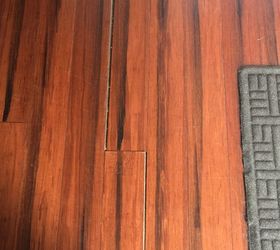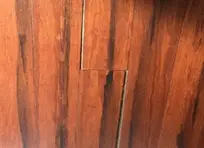Gaps in bamboo flooring can be both an eyesore and a potential hazard, but before diving into repairs, it’s crucial to understand what causes these gaps in the first place. Bamboo, like other natural wood materials, is highly sensitive to changes in temperature and humidity. Seasonal fluctuations can cause the bamboo planks to expand and contract, leading to the formation of gaps between the boards. In areas with high humidity, the planks may swell, only to shrink back during drier seasons, which can cause the gaps to appear more prominently. Additionally, improper installation, such as inadequate acclimation of the bamboo planks to the room’s environment or not leaving enough room for expansion, can exacerbate this issue. Understanding these causes is the first step in determining the most effective method to fix the gaps.
Images about How To Fix Gaps In Bamboo Flooring
How To Fix Gaps In Bamboo Flooring

Assessing the Severity of the Gaps
Before deciding on a repair method, it’s important to assess the severity of the gaps in your bamboo flooring. Minor gaps, which are common and often seasonal, may not require any immediate action. These small gaps often close up on their own as the climate changes. However, larger or more persistent gaps could indicate a more serious issue, such as improper installation or a more significant environmental problem. Measure the width of the gaps and note any patterns, such as whether they are concentrated in one area or evenly distributed across the floor. This assessment will help you determine whether the gaps can be addressed with simple DIY fixes or if more extensive professional repairs are needed.

DIY Solutions for Fixing Gaps in Bamboo Flooring
For minor gaps, there are several DIY solutions you can try to fix the problem. One common method is to use wood filler or bamboo-compatible putty to fill in the gaps. Choose a filler that matches the color of your bamboo flooring for a seamless appearance. Clean the gaps thoroughly before applying the filler to ensure proper adhesion. Another method is to use a rope or jute filler, particularly in larger gaps, which can be pressed into the space and then stained to match the flooring. Additionally, you can try gently tapping the boards back into place with a mallet and a wood block. This method is effective if the gaps are due to slight shifting of the planks rather than significant shrinkage. After fixing the gaps, apply a protective sealant to prevent further expansion and contraction.

Preventing Future Gaps in Bamboo Flooring
Once the gaps in your bamboo flooring have been repaired, it’s important to take steps to prevent them from reoccurring. Maintaining a stable indoor climate is key to minimizing the expansion and contraction of bamboo planks. Use a humidifier during the winter months when indoor air tends to be dry, and consider a dehumidifier in the summer if your area experiences high humidity. Additionally, ensure that your bamboo flooring is properly maintained by regularly cleaning it and avoiding excessive moisture. If you’re planning to install new bamboo flooring, make sure the planks are properly acclimated to your home’s environment before installation, and leave adequate space for expansion around the edges. By taking these preventative measures, you can enjoy the beauty of your bamboo flooring without the worry of future gaps.
How To Fix Floating Floor Gaps
How to Fix Gaps on Hardwood Flooring?
Separating bamboo floors – suggestions?
How To Fix A Bamboo Floor That Has Separated
Seasonal Expansion and Shrinkage in Hardwood Floors – Impressions
Can You and Should You Fix Gaps in Engineered Hardwood Floors
Related Posts:
- Vintage Bamboo Flooring
- Bamboo Flooring In Kitchens
- Installing Solid Bamboo Flooring
- Cheap Bamboo Flooring
- Bamboo Flooring Durability Review
- Dark Brown Bamboo Flooring
- Scratch Resistant Bamboo Flooring
- Bamboo Floor Repair Dents
- Bamboo Patio Flooring
- Engineered Bamboo Flooring
How to Fix Gaps in Bamboo Flooring
Bamboo flooring is a popular flooring option for many homeowners because of its durability and affordability. However, as with any type of flooring, it can be prone to developing gaps and cracks over time. If you’ve noticed that your bamboo flooring has developed some unsightly gaps, don’t worry — there are a few easy solutions that can help you repair the damage.
What Causes Gaps In Bamboo Flooring?
Gaps in bamboo flooring can be caused by a variety of factors, including moisture, temperature changes, movement of the subfloor, or even changes in the environment around it. In some cases, the gaps may be due to improper installation or a lack of maintenance. Whatever the cause, it’s important to address the issue as soon as possible to prevent further damage.
How To Fix Gaps In Bamboo Flooring
The first step in fixing gaps in bamboo flooring is to determine the cause of the gap. If the cause is environmental (temperature or humidity), then you may be able to resolve the problem by adjusting your thermostat or dehumidifier. If the gap is being caused by movement of the subfloor, then you may need to re-level the area or add additional support to keep the subfloor from shifting.
Once you’ve determined the cause of the gap, you can begin to fix it. One of the most effective ways to repair small gaps in bamboo flooring is with wood glue. Simply apply a thin layer of wood glue along the edges of the gap, then press the boards back into place and allow them to dry completely before walking on them again. For larger gaps, you may need to use shims or tongue-and-groove boards to fill in the space and provide additional support.
If your bamboo flooring is showing signs of wear and tear, you may also want to consider refinishing it. Refinishing your bamboo flooring will not only help close up any existing gaps but will also help protect the surface from future wear and tear. This can be done either by sanding down the existing finish and applying a new one or by applying a new finish directly over the existing one.
Can I use caulk instead of wood glue to fix gaps in my bamboo flooring?
While caulk can be used to fill small gaps in some types of flooring, it is not recommended for use on bamboo floors as it can be difficult to remove when repairs are needed in the future. Wood glue is a better option for repairing small gaps in bamboo floors as it is easy to remove and won’t leave behind any residue.
How often should I refinish my bamboo flooring?
Refinishing your bamboo flooring should be done every few years or when signs of wear and tear start to appear. Refinishing will not only help close up any existing gaps but will also help protect your floor from future damage and extend its lifespan significantly.
What should I do if I have large gaps in my bamboo flooring?
If you have large gaps in your bamboo flooring, you may need to use shims or tongue-and-groove boards to fill them in and provide additional support. Additionally, you may want to consider refinishing your floor as this can help close up any existing gaps and protect your floor from future wear and tear.
Gaps in bamboo flooring can be unsightly and difficult to repair if left unattended for too long. Fortunately, there are several easy steps you can take to fix small or large gaps in your floor quickly and effectively. Start by determining what is causing the issue, then use wood glue, shims, or tongue-and-groove boards to fill in any gaps and provide additional support as needed. Finally, consider refinishing your bamboo flooring every few years or when signs of wear and tear start to appear — this will help close up any existing gaps while also protecting your floor from future damage.






